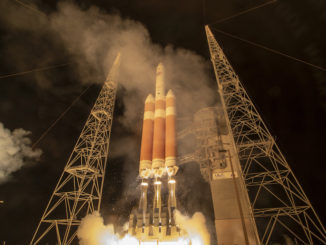Science
SpaceX Launches Dragon for Extended Cargo Mission to ISS

A SpaceX Falcon 9 rocket successfully lifted off from Cape Canaveral Space Force Station on August 24, 2025, initiating the company’s 33rd Commercial Resupply Services mission to the International Space Station (ISS). The Cargo Dragon spacecraft is transporting over 5,000 pounds of supplies, including vital scientific equipment and a new propulsion package designed for orbital maneuvers.
Docking is scheduled for Monday, August 25, at 07:30 EDT (11:30 UTC) at the Harmony module, marking the 50th successful mission of the Dragon spacecraft to the ISS. SpaceX’s director of Dragon Mission Management, Sarah Walker, highlighted the significance of these missions, stating, “These missions have flown well over 300,000 pounds of cargo and supplies to the orbiting lab and well over 1,000 science and research projects.”
Supporting Science and Research
The Dragon spacecraft, designated C211 for this mission, carries equipment necessary for over 50 science experiments and technology demonstrations. These projects include advancements in 3D metal printing and investigations into bone loss in microgravity. This mission will contribute to the ongoing research that has involved more than 280 residents and over 5,000 researchers from more than 110 countries over the past 25 years of human presence in low Earth orbit.
Heidi Parris, associate program scientist for NASA’s ISS Program Research Office, noted the extensive impact of the ISS, stating, “We’ve enabled more than 4,000 different scientific experiments and technology demonstrations.” This collaborative effort continues to yield valuable insights that benefit life on Earth.
Long-Duration Mission Enhances ISS Operations
The Dragon spacecraft is set to remain docked to the ISS for nearly five months, marking SpaceX’s first long-duration cargo mission. This extended stay allows Dragon to perform multiple orbital reboosts, assisting the ISS in maintaining its altitude while reducing reliance on Russian Progress vehicles and the station’s thrusters.
Walker expressed enthusiasm for the mission, sharing, “It’s been exciting for us to support this critical, new effort and it feels like we get to become an even more integrated part of the ISS operations ecosystem.”
In addition to this mission, SpaceX is also under contract with NASA to develop the U.S. Deorbit Vehicle, which is expected to be delivered between 2028 and 2029. This vehicle will be crucial for managing the final stages of the ISS’s operational life, as its partners prepare for the eventual decommissioning of the station around 2030.
The successful launch and ongoing collaboration between NASA and SpaceX exemplify the growing partnership in space exploration, promising continued advancements in science and technology.
-

 Lifestyle5 months ago
Lifestyle5 months agoLibraries Challenge Rising E-Book Costs Amid Growing Demand
-

 Sports5 months ago
Sports5 months agoTyreek Hill Responds to Tua Tagovailoa’s Comments on Team Dynamics
-

 Sports5 months ago
Sports5 months agoLiverpool Secures Agreement to Sign Young Striker Will Wright
-

 Lifestyle5 months ago
Lifestyle5 months agoSave Your Split Tomatoes: Expert Tips for Gardeners
-

 Lifestyle5 months ago
Lifestyle5 months agoPrincess Beatrice’s Daughter Athena Joins Siblings at London Parade
-

 Science4 months ago
Science4 months agoSan Francisco Hosts Unique Contest to Identify “Performative Males”
-

 World5 months ago
World5 months agoWinter Storms Lash New South Wales with Snow, Flood Risks
-

 Science5 months ago
Science5 months agoTrump Administration Moves to Repeal Key Climate Regulation
-

 Business5 months ago
Business5 months agoSoFi Technologies Shares Slip 2% Following Insider Stock Sale
-

 Science5 months ago
Science5 months agoNew Tool Reveals Link Between Horse Coat Condition and Parasites
-

 Sports5 months ago
Sports5 months agoElon Musk Sculpture Travels From Utah to Yosemite National Park
-

 Science5 months ago
Science5 months agoNew Study Confirms Humans Transported Stonehenge Bluestones









